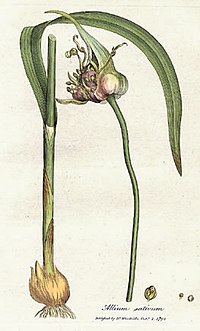
Photo from wikipedia
Background: Previous animal and clinical studies have reported beneficial effects of garlic preparations on carotid intima-media thickness (cIMT). However, no epidemiological study has yet investigated the association between dietary raw… Click to show full abstract
Background: Previous animal and clinical studies have reported beneficial effects of garlic preparations on carotid intima-media thickness (cIMT). However, no epidemiological study has yet investigated the association between dietary raw garlic consumption and cIMT in the general population. The objective of this study was investigating the association between dietary raw garlic consumption and thickened cIMT in Chinese adults. Methods: This cross-sectional study used data from the Tianjin Chronic Low-grade Systemic Inflammation and Health Cohort Study. A total of 4,329 general adults from 2015 to 2017 were included in this study. Frequency of consumption of raw garlic was summarized as four categories for analysis: < 1 time/week, 1 time/week, 2-3 times/week, ≥4 times/week with a validated food frequency questionnaire. The thickened cIMT was defined as common carotid artery IMT ≥ 1.0 mm or a carotid bifurcation IMT ≥ 1.2 mm by ultrasonography. Multivariable logistic regression analysis was used to examine the association between frequency of raw garlic consumption and thickened cIMT. Results: The prevalence of thickened cIMT is 22.9% among these participants. The adjusted odds ratios (95% confidence intervals) associated with the different frequencies were 1.00 (reference) for < 1 time/week, 0.74 (0.59, 0.94) for 1 time/week, 0.71 (0.55, 0.92) for 2–3 times/week, and 0.94 (0.71, 1.25) for ≥ 4 times/week. Conclusions: Light-to-moderate raw garlic consumption was inversely associated with thickened cIMT, whereas greater raw garlic consumption (i.e., ≥4 times/week) was not associated with thickened cIMT. Future longitudinal studies should be conducted to test these findings.
Journal Title: Frontiers in Nutrition
Year Published: 2021
Link to full text (if available)
Share on Social Media: Sign Up to like & get
recommendations!